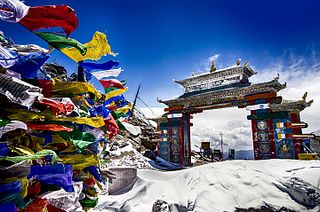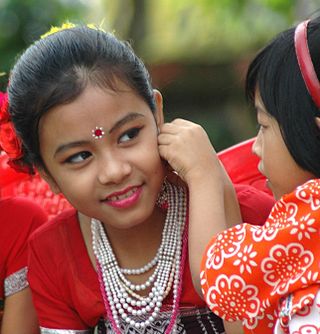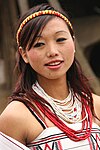Related Research Articles

Tripura is a state in northeastern India. The third-smallest state in the country, it covers 10,491 km2 (4,051 sq mi); and the seventh-least populous state with a population of 3.67 million. It is bordered by Assam and Mizoram to the east and by Bangladesh to the north, south and west. Tripura is divided into 8 districts and 23 sub-divisions, where Agartala is the capital and the largest city in the state. Tripura has 19 different tribal communities with a majority Bengali population. Bengali, English and Kokborok are the state's official languages.

Northeast India, officially the North Eastern Region (NER), is the easternmost region of India representing both a geographic and political administrative division of the country. It comprises eight states—Arunachal Pradesh, Assam, Manipur, Meghalaya, Mizoram, Nagaland and Tripura, and the "brother" state of Sikkim.

Kokborok (or Tripuri) is a Tibeto-Burman language of the Indian state of Tripura and neighbouring areas of Bangladesh. Its name comes from kók meaning "verbal" or "language" and borok meaning "people" or "human", It is one of the ancient languages of Northeast India.

The Tripuri people (Kókborok: Tripuri dópha rok, are a Tibeto-Burman-speaking ethnic group of Bangladesh and Northeast Indian state of Tripura. They are the descendants of the inhabitants of the Twipra/Tripura Kingdom in North-East India and Bangladesh. The Tripuri people through the Manikya dynasty ruled the Kingdom of Tripura for over 600 years starting from 1400 A.D. until the kingdom joined the Indian Union on 15 October 1949. The Tipra Dynasty was established in 590 AD.
The Dances of Tripura refer to several forms of folk dance performed in the state of Tripura in northeastern India. These dances are performed by the Tripuri and Mog peoples, during annual regional celebrations, such as sowing and harvesting festivals.

The Jamatias are one of the main Tripuri clans of Tripura and the only such clan with its own customary law in practice, which is called Jamatia Raida.
Reang is one of the Tripuri clan of the Northeast Indian state. The Reangs can be found all over the Tripura state in India. However, they may also be found in Assam and Mizoram. They speak the Reang dialect similar to Kokborok language, which has Tibeto-Burmese roots and is locally known as Kau Bru.
Noatia are one of the Tripuri clan of Tripura state of India. The clan mainly lives in the North Tripura districts of the Tripura state of India. They speak the Noatia dialect of Kokborok which is of Tibeto-Burmese origin.
The Hrangkhawls are the subtribe of the Hmars and they speak the Hrangkhawl dialect of Tibeto-Burmese origin. Though the majority of the Hmars speak the lingua-franca of the Hmar i.e Khawsak țawng/Literary Hmar, many of the 20+ Hmar subtribes(such as Faihriem țawng, Leiri țawng,Țhiek țawng, Zote țawng, Darngawn țawng, etc)also speak their own dialect just like the Hrangkhawls.In the history of the Hmars specifically around the 15th century AD, the Hmar subtribes were united by Rêngpui(Great king/great ruler;title) Chawnhmang Buhril who placed 6 Rêngtes(Lesser/smaller rulers;title) who were effectively regional rulers and also had village chiefs and so under them. Here, in this era the northern regional ruler was Demlukim Hrangkhawl who ruled from Mawmrang village in present day Saitual district of Mizoram, and by the late stages of Rêngpui Chawnhmang's reign, it was recorded that he gave all his Rêngtes royal gifts before he departed for Tripura.For Rêngte Demlukim Hrangkhawl, the Rêngpui gave him a pinto/spotted horse and after that, taking many of his Hrangkhawl and Darlawng subjects, he migrated to Tripura. This is also the reason why Tripura is known to the Hmars(Mizos) as "Rêngram"(Land of the Rêng/Ruler). They are listed as one of the 21 scheduled tribes of Indian state Tripura. Archived 2018-12-07 at the Wayback Machine They are mainly dwelling in the Teliamura sub-division of West Tripura and the Ambassa sub-division of Dhalai Archived 2023-10-03 at the Wayback Machine districts. The Hrangkhawls are also found in the North Cachar Hills of Dima Hasao district, Assam, Mizoram, Manipur and Myanmar.

Tripuris have their own traditional dresses. This type of dress is similar to that of the rest of the North-East Indian people, but the pattern and design is totally different.
The Halam community are various tribes native to the state of Tripura in India. The name Halam was coined by the Tipra Maharaja. As per their oral tradition they called themselves "Riam", which literally means "Human being". And lyrically they also call themselves "Riamrai, Chepvon, Reivon, Longvon etc.". The Halam are further divided into 12 sub-tribes, namely Sakachep, Chorei, Molsom, Hrangkhol, Kaipeng, Kalai, Ranglong, Thangachep, Bongcher, Korbwng, Dab and Rupini.
Tripuri Nationalism is an ideology that supports self-determination by the Tripuri people. The conflict is in essence ethnic and the Tripuri community, indigenous to the region formed the clear majority of population in the princely state of Tippera, which joined the Republic of India in 1949 as the state of Tripura.

The culture of Tripura is distinct and a bit similar to other people of Northeast India. However like Assam, Manipur, Burma and Southeast Asia culture of Tripura is characterized in small portion where people live in plain and hill areas. Tripura is a state in North East India. In the 2001 census of India, Bengalis represented almost 70% of the population and the Tripuri population comprised 30% of Tripura's population. The Tripuri population comprises some clans and ethnic groups with diverse languages and cultures. The largest native group was the Tripuri who had a population of 543,848 in 2001 census, representing 16.99% of the state population and 54.7% of the scheduled tribe population. The other group of people in order of decreasing population were Chakma (6.5%), Halam (4.8%), Mog (3.1%), Munda, Kuki tribes and Garo Hajong. Bengali is the most spoken language, due to the dominance of Bengali people in the state. Kokborok (Tripuri/Tiprakok) is a common language among Tripuris and lingua franca in Tripura. Several other languages belonging to Indo-European and Sino-Tibetan families are spoken by the different tribe
Tripuri Kshatriya is a Vaishnav caste group which encompasses almost all the members of the Tripuri, Reang, Jamatia and Noatia ethnic groups, most of whom live in the Indian state of Tripura. The Tripuri Royal Family belonged to the Tripuri ethnic group, from the Debbarma clan. Originally the term "Tripur Kshatriya" was used to denote the Tripuri ethnic group only, but in due time, the Maharajah included the remaining three ethnic groups as well, in an attempt to foster a sense of kinship among his people. With the influx of the Bengali immigrants from neighboring places, the Tripuris lost their majority in their own kingdom and the Maharajah's power was taken away by the Indian government. Formerly, the community was organized under the Tripura Kshatriya Samaj, which was headed by the Maharajah of Tripura himself.
Ranglong is an ethnic people belonging to the Kuki people. The majority of the Ranglong people live in a small and densely-packed area in the northeastern part of India, mainly in the border areas of Tripura, Assam and Mizoram.

The following outline is provided as an overview of and topical guide to Tripura:

Kokborok Cinema also known as Tripuri Cinema refers to the Kokborok language film industry in Tripura, India and among the Tripuri people. Tripura's Kokborok film industry began in 1986 with Longtharai (1986) directed by Dipak Bhattacharya adapted from Bimal Sinha's novel Karachi theke Longtharai depicting the struggle-ridden life of jhum cultivators in the rural hills of Longtharai followed by the Kokborok film Langmani Haduk (1993) directed by Ruhi Debbarma can be read as a critique of the modern regime. The Kokborok film Mathia (2004) directed by Joseph Pulinthanath, is the first International Award-winning Kokborok film.
Langmani Haduk is a 1993 Tripuri feature film in Kokborok language directed by Ruhi Debbarma that portrayed patriarchal norms through what may be referred to as "feudal familial romance." It took inspiration from the well-established social/family melodramas of Hindi cinema.
References
- ↑ Palombini, Felipe Luis; Nogueira, Fernanda Mayara (14 March 2023). Bamboo Science and Technology. Springer Nature. p. 216. ISBN 978-981-99-0015-2.
- ↑ Dutta, Subrata Kumar (2005). Uprooted Reangs: Strangers in Their Motherland. Akansha Publishing House. p. 33. ISBN 978-81-87606-91-8.
- "Change name from Usoi to Kaobrung". Ethnologue. 14 November 2018. Retrieved 12 August 2020.
